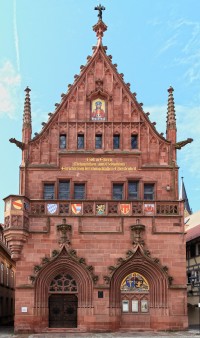Vorderseite: Im Blätterkranz der Dom zu Speyer als Stadtwappen zwischen *-*. Umschrift: ERHALT O HERR . DIE STAT . SPEIER . BEI . DEINEM . WORT.
Rückseite: Im Blätterkranz EVANGELII . REPVRGATI . A°. DOMINI . MDXVII. Im Feld in vier Zeilen NVM= / MVS. IVBI= / LAEVS . ANNO / MDCXVII (= [zusammen mit der Umschrift] Jubiläumsmünze im Jahre 1617 zur Reinigung des Evangeliums im Jahre 1517), darunter ein kleiner Rosenkranz.
en

